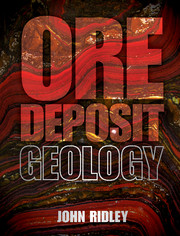Book contents
- Frontmatter
- Contents
- List of boxes
- Preface
- Acknowledgements
- 1 What is an ore deposit?
- 2 Magmatic ore deposits
- 3 Hydrothermal ore deposits I: magmatic and orogenic environments
- 4 Hydrothermal ore deposits II: sedimentary environments
- 5 Ore deposits formed in sedimentary environments
- 6 Supergene ores and supergene overprinting of ores
- Glossary
- References
- Index
3 - Hydrothermal ore deposits I: magmatic and orogenic environments
- Frontmatter
- Contents
- List of boxes
- Preface
- Acknowledgements
- 1 What is an ore deposit?
- 2 Magmatic ore deposits
- 3 Hydrothermal ore deposits I: magmatic and orogenic environments
- 4 Hydrothermal ore deposits II: sedimentary environments
- 5 Ore deposits formed in sedimentary environments
- 6 Supergene ores and supergene overprinting of ores
- Glossary
- References
- Index
Summary
A hydrothermal ore deposit is one in which the ore minerals were precipitated from aqueous high-temperature fluid solutions, where:
Aqueous implies that the solvent is water. The fluids are solutions, and can have salinities up to several times that of seawater. They are in some cases concentrated brines in which salts form more than half the solution by mass. Additionally the fluid may be a solution of water and dissolved gases (e.g. CO2).
High temperature can be from normal rock temperatures at a few kilometres depth (≈ 100 °C) to magmatic temperatures (≈ 800 °C).
Fluid is a liquid or vapour or gas. These four words are used somewhat interchangeably. Most hydrothermal fluids at high temperature and pressure have a density intermediate between that of liquid water and that of water vapour at surface conditions. At temperatures greater than the critical temperature of pure water (376 °C), liquid-like pure water will not boil with either decreasing pressure or increasing temperature, but will steadily become less dense (Figure 3.1). The term supercritical fluid is used for these environments. Saline waters can boil at higher temperatures to produce a dense saline brine and a less-dense weakly saline fluid or vapour, and this fact affects the evolution of the highest temperature hydrothermal fluids that are associated with magmas.
Ore minerals may precipitate in the subsurface in void space in rocks or by replacement of other minerals, or at the interface between rocks and water bodies or the atmosphere (e.g. on the ocean floor).
- Type
- Chapter
- Information
- Ore Deposit Geology , pp. 92 - 240Publisher: Cambridge University PressPrint publication year: 2013
- 1
- Cited by



